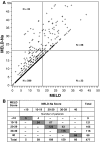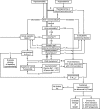Hyponatremia in cirrhosis and end-stage liver disease: treatment with the vasopressin V₂-receptor antagonist tolvaptan
- PMID: 22732834
- PMCID: PMC3472061
- DOI: 10.1007/s10620-012-2276-3
Hyponatremia in cirrhosis and end-stage liver disease: treatment with the vasopressin V₂-receptor antagonist tolvaptan
Abstract
Hyponatremia is common in patients with cirrhosis and portal hypertension, and is characterized by excessive renal retention of water relative to sodium due to reduced solute-free water clearance. The primary cause is increased release of arginine vasopressin. Hyponatremia is associated with increased mortality in cirrhotic patients, those with end-stage liver disease (ESLD) on transplant waiting lists, and, in some studies, posttransplantation patients. Clinical evidence suggests that adding serum sodium to model for ESLD (MELD) scoring identifies patients in greatest need of liver transplantation by improving waiting list mortality prediction. Hyponatremia is also associated with numerous complications in liver disease patients, including severe ascites, hepatic encephalopathy, infectious complications, renal impairment, increased severity of liver disease in cirrhosis, and increased hospital stay and neurologic/infectious complications posttransplant. Vasopressin receptor antagonists, which act to increase free water excretion (aquaresis) and thereby increase serum sodium concentration, have been evaluated in patients with hypervolemic hyponatremia (including cirrhosis and heart failure) and euvolemic hyponatremia (SIADH). Tolvaptan, a selective vasopressin V(2)-receptor antagonist, is the only oral agent in this class approved for raising sodium levels in hypervolemic and euvolemic hyponatremia. The SALT trials showed that tolvaptan treatment rapidly and effectively resolved hyponatremia in these settings, including cirrhosis, and it has been shown that this agent can be safely and effectively used in long-term treatment. Fluid restriction should be avoided during the first 24 h of treatment to prevent overly rapid correction of hyponatremia, and tolvaptan should not be used in patients who cannot sense/respond to thirst, anuric patients, hypovolemic patients, and/or those requiring urgent intervention to raise serum sodium acutely.
Figures





Comment in
-
Letter in response to the recently published review: hyponatremia in cirrhosis and end-stage liver disease--treatment with the vasopressin v2-receptor antagonist tolvaptan.Dig Dis Sci. 2013 Mar;58(3):889-90. doi: 10.1007/s10620-013-2573-5. Epub 2013 Jan 31. Dig Dis Sci. 2013. PMID: 23371016 No abstract available.
Similar articles
-
Tolvaptan, a selective oral vasopressin V2-receptor antagonist, for hyponatremia.N Engl J Med. 2006 Nov 16;355(20):2099-112. doi: 10.1056/NEJMoa065181. Epub 2006 Nov 14. N Engl J Med. 2006. PMID: 17105757 Clinical Trial.
-
Treatment of hypervolemic or euvolemic hyponatremia associated with heart failure, cirrhosis, or the syndrome of inappropriate antidiuretic hormone with tolvaptan: a clinical review.Clin Ther. 2010 Jun;32(6):1015-32. doi: 10.1016/j.clinthera.2010.06.015. Clin Ther. 2010. PMID: 20637957 Review.
-
Letter in response to the recently published review: hyponatremia in cirrhosis and end-stage liver disease--treatment with the vasopressin v2-receptor antagonist tolvaptan.Dig Dis Sci. 2013 Mar;58(3):889-90. doi: 10.1007/s10620-013-2573-5. Epub 2013 Jan 31. Dig Dis Sci. 2013. PMID: 23371016 No abstract available.
-
Tolvaptan, an oral vasopressin antagonist, in the treatment of hyponatremia in cirrhosis.J Hepatol. 2012 Mar;56(3):571-8. doi: 10.1016/j.jhep.2011.08.020. Epub 2011 Oct 23. J Hepatol. 2012. PMID: 22027579 Clinical Trial.
-
Hyponatremia, heart failure, and the role of tolvaptan.Postgrad Med. 2012 Mar;124(2):29-39. doi: 10.3810/pgm.2012.03.2534. Postgrad Med. 2012. PMID: 22437213 Review.
Cited by
-
Hyponatremia Prevalence in Decompensated Chronic Liver Disease: Insights from a Tertiary Care Hospital.Cureus. 2024 Sep 7;16(9):e68907. doi: 10.7759/cureus.68907. eCollection 2024 Sep. Cureus. 2024. PMID: 39381467 Free PMC article.
-
Urinary excretion of the water channel aquaporin 2 correlated with the pharmacological effect of tolvaptan in cirrhotic patients with ascites.J Gastroenterol. 2016 Jun;51(6):620-7. doi: 10.1007/s00535-015-1143-3. Epub 2015 Nov 26. J Gastroenterol. 2016. PMID: 26610908
-
Is Exaggerated Release of Arginine Vasopressin an Endocrine Disorder? Pathophysiology and Treatment.J Clin Med. 2017 Oct 31;6(11):102. doi: 10.3390/jcm6110102. J Clin Med. 2017. PMID: 29088071 Free PMC article. Review.
-
Increase in hypotonic stress-induced endocytic activity in macrophages via ClC-3.Mol Cells. 2014 May;37(5):418-25. doi: 10.14348/molcells.2014.0031. Epub 2014 May 16. Mol Cells. 2014. PMID: 24850147 Free PMC article.
-
Current approaches to the management of patients with cirrhotic ascites.World J Gastroenterol. 2019 Jul 28;25(28):3738-3752. doi: 10.3748/wjg.v25.i28.3738. World J Gastroenterol. 2019. PMID: 31391769 Free PMC article. Review.
References
-
- Llach J, Ginès P, Arroyo V, et al. Prognostic value of arterial pressure, endogenous vasoactive systems, and renal function in cirrhotic patients admitted to the hospital for the treatment of ascites. Gastroenterology. 1988;94:482–487. - PubMed
Publication types
MeSH terms
Substances
LinkOut - more resources
Full Text Sources
Other Literature Sources
Medical

